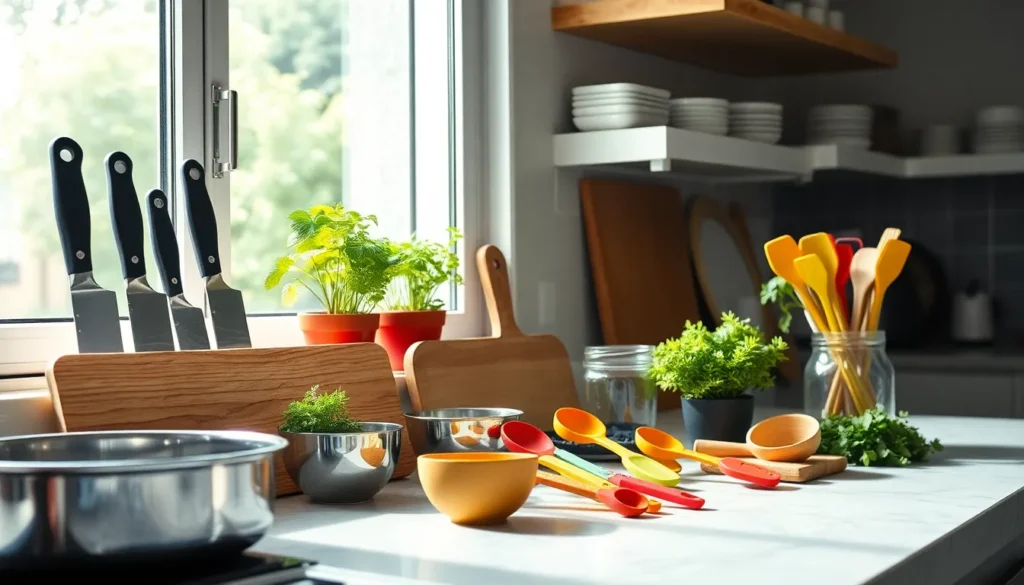In the world of culinary delights, the right cooking equipment can be the secret ingredient that transforms a mediocre meal into a masterpiece. Imagine whipping up a gourmet dinner with just a few tools that make you feel like a kitchen wizard. From the humble spatula to the mighty chef’s knife, each piece of equipment plays a vital role in your culinary adventures.
But let’s be honest—navigating the sea of pots, pans, and gadgets can feel like trying to find a needle in a haystack. With so many options out there, it’s easy to get overwhelmed. Fear not! This guide will help you sift through the clutter, ensuring you invest in equipment that not only meets your needs but also adds a sprinkle of joy to your cooking experience. After all, who wouldn’t want to cook like a pro while having a good laugh?
Table of Contents
ToggleTypes of Cooking Equipment
Cooking equipment ranges from everyday essentials to specialty items, each playing a crucial role in meal preparation. Understanding these tools promotes efficient cooking experiences.
Essential Kitchen Tools
Essential kitchen tools include knives, cutting boards, measuring cups, and spatulas. Knives, often regarded as the most vital items, facilitate precise slicing and dicing. Cutting boards serve as protective surfaces, crucial for maintaining a clean workspace. Measuring cups enable accurate ingredient quantities, which ensures consistent results. Spatulas assist in flipping and serving food, providing versatility. These fundamental tools establish the foundation for effective cooking.
Specialty Cooking Tools
Specialty cooking tools encompass items designed for specific culinary tasks. For instance, a mandoline slicer permits thin, uniform vegetable cuts. An immersion blender allows for pureeing soups directly in the pot, simplifying the process. Sous vide equipment offers precise temperature control, enhancing the quality of meats and vegetables. Specialty bakeware serves distinct purposes, such as silicone molds for easy release. Investing in these tools often elevates cooking techniques and introduces new textures and flavors.
Material Considerations

Material selection affects not only cooking performance but also durability and maintenance. Understanding the properties of various materials helps in choosing the right cooking equipment.
Stainless Steel vs. Non-Stick
Stainless steel offers excellent heat conduction and resistance to corrosion. It’s ideal for browning and searing due to its ability to withstand high temperatures. Non-stick cookware simplifies food release and cleaning, making it popular for everyday use. While non-stick surfaces require careful handling to avoid scratches, stainless steel can tolerate metal utensils. Each material excels in specific cooking scenarios, emphasizing the importance of having both in a well-equipped kitchen.
Cast Iron vs. Copper
Cast iron retains heat effectively, providing even cooking temperatures, making it perfect for slow-cooked dishes. This material’s ability to develop a natural non-stick surface with seasoning enhances its versatility. Copper, on the other hand, offers superior heat conductivity, allowing for precise temperature control. It’s beneficial for delicate tasks such as candy-making or sauce preparation. Each material’s unique attributes cater to different culinary techniques, reinforcing the necessity for diverse tools in a cooking arsenal.
Popular Cooking Equipment Brands
Various brands offer cooking equipment that caters to different needs and budgets. This section explores both budget-friendly options and high-end choices.
Budget-Friendly Options
Brands like T-fal and Oster provide affordable yet reliable cooking tools. T-fal, known for its non-stick cookware, offers easy-to-use products that simplify meal preparation. Oster focuses on kitchen appliances like blenders and toasters, ensuring functionality at a lower price point. Their durable designs withstand daily use. Additionally, brands such as Pyrex and Rubbermaid feature essential tools like measuring cups and storage containers. These items help maintain an organized kitchen and improve cooking efficiency. Choosing budget-friendly options allows everyone to access quality equipment without overspending.
High-End Choices
High-end brands like All-Clad and Le Creuset deliver exceptional quality and performance. All-Clad specializes in stainless steel cookware, renowned for its heat distribution and durability. Many professional chefs endorse this brand for consistency in cooking results. Le Creuset, famous for its enameled cast iron products, offers vibrant Dutch ovens that excel at slow cooking and braising. Their products combine aesthetics with functionality, enhancing any kitchen. Additionally, brands such as KitchenAid provide premium stand mixers and culinary tools, perfect for serious home cooks. Investing in high-end choices elevates cooking experiences and cultivates culinary artistry.
Maintenance and Care
Proper maintenance enhances the longevity and performance of cooking equipment. Staying consistent with care routines prevents damage and ensures optimal functioning.
Cleaning Techniques
Cleaning techniques vary based on equipment materials. Use warm, soapy water for stainless steel and cast iron to prevent rust. Non-stick surfaces require gentle sponges to avoid scratches. Avoid using abrasive cleaners on delicate materials. For burnt food, soak pots and pans before scrubbing. Rinse thoroughly and dry immediately to prevent water spots. Regularly clean kitchen tools such as spatulas and measuring cups to maintain hygiene. Ensure that air-drying occurs for wooden utensils to prevent cracking.
Storage Tips
Storage tips contribute to the durability of cooking tools. Organize pots and pans with dividers to prevent scratches. Utilize drawer organizers for cutlery to enhance accessibility. Hanging racks work well for frequently used utensils, keeping them within reach. Keep lids separately stored to avoid confusion and damage. In addition, store non-stick cookware nesting with protection between each piece. Designating space for specialty tools maintains an orderly kitchen. Regularly evaluate storage solutions to adapt to changing equipment needs.
Choosing the right cooking equipment can transform any culinary endeavor. It’s not just about having the latest gadgets but understanding which tools best suit individual cooking styles and preferences. Investing in quality equipment and maintaining it properly ensures a more enjoyable and efficient cooking experience.
With the right essentials and specialty tools at their disposal, anyone can elevate their meals and explore new culinary techniques. A well-organized kitchen fosters creativity and confidence, making it easier to experiment and refine skills. Ultimately, the journey in the kitchen is enhanced by the thoughtful selection of tools that inspire and empower every cook.





